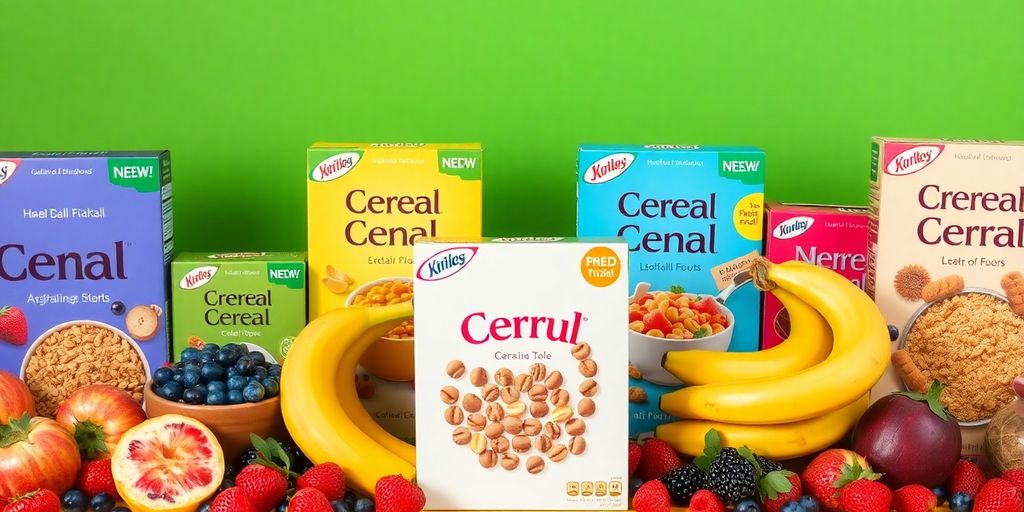Choosing a breakfast cereal in Australia can feel like a minefield, with so many options lining the supermarket shelves. It’s easy to get lost in the marketing and the sheer variety, making it tough to pick something genuinely good for you. But don’t stress, we’re going to cut through the noise and figure out which cereals are actually worth your money and will give you a good start to the day. We’ll look at what makes a cereal healthy, focusing on things like fibre and sugar, and then highlight some top picks you can find right here in Australia.
Key Takeaways
- When picking a cereal, aim for one that lists ‘wholegrain’ as a main ingredient, ideally making up 50% or more of the product.
- Look for cereals with a good amount of fibre, aiming for at least 10 grams per 100 grams to help keep you full and support digestion.
- Keep an eye on sugar content; try to choose cereals with less than 10-15 grams of sugar per 100 grams, and opt for natural sweetness from fruit when possible.
- The Health Star Rating (HSR) is a useful guide, but remember to compare cereals within the same category to get the best idea of which is healthier.
- Adding seeds, nuts, or fresh fruit to your cereal can boost its nutritional value, adding fibre, protein, and healthy fats.
Understanding Cereal Health Stars

When you’re trying to figure out what to put in your breakfast bowl, the Health Star Rating (HSR) system on the front of the box can seem like a helpful shortcut. It’s designed to give you a quick snapshot of how a product stacks up nutritionally, comparing it to similar items. Basically, it looks at the good stuff like fibre, protein, and any fruit or nuts, and balances that against the not-so-good stuff like kilojoules, saturated fat, sodium, and sugar. It’s a handy starting point for making healthier choices.
However, it’s not always as straightforward as it looks. The HSR is really only useful when you’re comparing products that are alike – you can’t really use it to compare, say, a bowl of oats to a slice of bread. Plus, sometimes highly processed foods can get a decent star rating because they’ve had fibre or protein added in. It’s a bit like looking at a shiny wrapper; it might look good, but you still need to peek inside.
Decoding the Health Star Rating System
The Health Star Rating system is designed to help consumers quickly and easily compare the nutrition of similar products. It assigns a rating out of five stars, with more stars indicating a healthier choice. The rating is calculated based on the amount of energy, saturated fat, sodium, and sugars in a product, balanced against the presence of beneficial nutrients like protein, fibre, and the inclusion of fruits, vegetables, nuts, and legumes. This system aims to simplify nutritional information, making it easier for shoppers to make informed decisions at a glance.
Comparing Like With Like: Limitations of HSR
While the Health Star Rating is a useful tool, it’s important to remember its limitations. The system is most effective when comparing similar food categories. For instance, you can compare one breakfast cereal to another, or one type of yoghurt to another. However, comparing a cereal’s star rating to that of a canned vegetable wouldn’t provide a meaningful nutritional comparison. It’s also worth noting that some products might achieve a higher star rating through fortification or the addition of certain ingredients, which might not always reflect the overall natural goodness or minimal processing of a product.
Beyond the Stars: What Else to Consider
Don’t let the Health Star Rating be the only factor in your decision. Always check the ingredients list and the nutrition information panel. Look for cereals with whole grains as the primary ingredient, aim for a high fibre content (over 10g per 100g is great), and keep an eye on added sugars and sodium. Sometimes, a product with a slightly lower star rating but with fewer ingredients and less processing might actually be a better choice for your daily breakfast. It’s about getting a balanced view of what you’re eating.
Key Nutritional Benchmarks for Healthy Cereals

When you’re scanning the cereal aisle, it’s easy to get lost in all the colourful boxes and catchy claims. But if you’re aiming for a healthier start to your day, there are a few key nutritional markers you should keep an eye on. It’s not just about the Health Star Rating, though that’s a good starting point. We need to dig a bit deeper into what’s actually in the box.
Prioritising Wholegrains: Aiming for 50% or More
Think of wholegrains as the backbone of a good cereal. They’re packed with fibre, vitamins, and minerals that refined grains often lose during processing. The more wholegrain content, the better, really. Look for cereals that proudly state they contain 50% or more wholegrains on the front of the packaging. This usually means you’re getting a more substantial, filling breakfast that will keep you going longer. It’s a simple way to boost your daily intake of these important nutrients, and many Australian businesses are focusing on these healthier options food industry.
The Fibre Factor: Targeting Over 10g Per 100g
Fibre is your friend, especially at breakfast. It helps with digestion, keeps you feeling full, and can even help manage cholesterol levels. Most of us don’t get enough fibre in our diets, so choosing a cereal with a high fibre content is a smart move. Aim for anything over 10 grams of fibre per 100 grams. This is where you’ll often find cereals like bran-based options or plain rolled oats really shine. They’re not always the most exciting, but they do the job.
Navigating Sugar Content: Less Than 10-15g Per 100g
This is where things can get a bit tricky. Many cereals, especially those marketed towards kids (and let’s be honest, adults too!), are loaded with added sugar. You want to keep that added sugar as low as possible. A good benchmark is to look for cereals with less than 10 grams of sugar per 100 grams. If you find a cereal that’s slightly higher, say between 10-15g per 100g, but it’s also very high in fibre, it might still be a decent choice. Just try to avoid those with sugar listed as one of the very first ingredients. Adding fresh fruit is a much better way to sweeten your bowl.
Sodium Savvy: Keeping Salt Intake Low
While fibre and sugar often get the spotlight, sodium (salt) is another ingredient to watch. Some cereals can be surprisingly high in salt, which isn’t ideal for everyday consumption. While the exact target can vary, generally speaking, the lower the sodium content, the better. It’s worth checking the nutrition panel for this, especially if you’re monitoring your salt intake for health reasons. You don’t want your breakfast to contribute significantly to your daily sodium allowance.
Choosing a cereal that ticks these boxes – high wholegrains, plenty of fibre, low sugar, and not too much salt – sets you up for a much healthier start to your day. It’s about making informed choices that benefit your body.
Top Cereal Picks for the Health-Conscious Aussie
So, you’ve decided to take charge of your breakfast bowl and ditch the sugary stuff. Good on ya! But with so many options lining the supermarket shelves, how do you actually pick a winner? Let’s break down some of the top contenders that consistently get a nod from the health-conscious crowd.
Kellogg’s Guardian: A Simple, Nutrient-Rich Choice
This one’s a bit of a classic, and for good reason. It’s not trying to be fancy, just straightforward goodness. Guardian is known for being pretty simple, with not a lot of extras thrown in. Initially, it might not taste super sweet, but give your taste buds a chance to adjust, and you’ll find a subtle sweetness that’s quite satisfying. It often scores a full five stars on the Health Star Rating system, and honestly, it’s easy to see why. It’s a solid, no-fuss option that’s packed with nutrients.
Kellogg’s All-Bran: High Fibre Champion
Whether you go for the Wheat Flakes or the Original version, All-Bran is a standout for its seriously high fibre content. If you’re someone who needs a little help keeping things moving, this is a fantastic choice. I’ve found that in winter, a great way to enjoy the Original is to add milk, microwave it until it’s like porridge, and then sprinkle on some cinnamon and seeds. It’s really tasty and keeps you full for ages.
Sanitarium Weet-Bix: The Fortified Aussie Staple
Weet-Bix is practically an Australian institution, isn’t it? It’s made from 97% wholegrains, making it a powerhouse of fibre and nutrients. It’s also fortified with essential vitamins and minerals, which is a big plus. It’s a simple, versatile base that you can jazz up however you like. It’s a reliable choice that’s been a breakfast favourite for generations, and it’s easy to see why it remains so popular. You can find a great range of breakfast options at many Melbourne cafes.
Uncle Toby’s Shredded Wheat: Minimally Processed Powerhouse
Another straightforward option that’s worth a look is Uncle Toby’s Shredded Wheat. It’s praised for its high fibre and low sugar content, often earning a five-star Health Star Rating. It’s a good example of a cereal that keeps processing to a minimum, letting the natural goodness of the wheat shine through. It’s a simple, honest cereal that does the job well.
Exploring High-Fibre and Low-Sugar Alternatives
Sometimes the big names aren’t the only players in the game when it comes to a decent breakfast. If you’re looking to boost your fibre intake or cut down on the sweet stuff, there are some excellent alternatives out there that might not be front and centre on the supermarket shelf. It’s all about digging a little deeper and checking those nutrition labels, you know?
Goodness Superfoods: Fibre-Rich Options
Goodness Superfoods is an Australian brand that really focuses on packing in the fibre. Their ‘Protein 1st’ variety, often in a green box, is a standout if you’re trying to get more fibre into your diet. Just a heads-up, though, such high fibre content can sometimes cause a bit of digestive upset for some people, so it’s worth seeing how your tummy handles it. But for many, it’s a fantastic way to start the day.
Uncle Toby’s Bran Plus: A Worthy Competitor
Think of Uncle Toby’s Bran Plus as a close cousin to the more well-known All-Bran. It’s a really solid choice and a great alternative if you’re looking for something similar. They offer a few different products in this range, so you can try them out and see which one you prefer. Just don’t get it mixed up with their ‘Fibre Plus’ product, as they’re quite different.
Vogel’s Ultra Bran and Soy: A Lesser-Known Gem
This one might not be as familiar to everyone, but Vogel’s Ultra Bran and Soy is definitely worth a look. It’s high in fibre, low in sugar, and surprisingly tasty. It’s not the trendiest option, but the simple ingredients, low GI rating, and subtle flavour make it a really healthy breakfast cereal. It’s a good example of how sometimes the less obvious choices are the best ones. You can find some great deals on cereals like this if you shop around, perhaps even at places like Perth’s plant-based cafes.
When you’re comparing cereals, always check the ingredients list. Ideally, you want sugars to come from natural sources like fruit, rather than added refined sugars. This makes a big difference to the overall health profile of your breakfast.
Sweetening Your Cereal Naturally
So, you’ve picked a great cereal, high in fibre and low in sugar. Awesome! But maybe it’s a bit… plain? Don’t reach for the sugar bowl just yet. There are heaps of ways to add a touch of sweetness without derailing all your good work. The key is to use natural sources of sweetness and be mindful of how much you’re adding.
The Pitfalls of Added Sugars in Cereals
It’s easy to get caught out by the sugar in breakfast cereals. Many cereals, especially those marketed to kids, are loaded with added sugars. These can sneak in under various names like glucose, sucrose, maltodextrin, or even honey and maple syrup. While a little sweetness is nice, too much added sugar can lead to energy spikes and crashes, and it’s just not great for our overall health. It’s best to aim for cereals with less than 10g of sugar per 100g, and if you do need a bit more sweetness, try adding your own. Remember, sugar can be sneaky and might be hiding in the ingredients list under many different names. Here are examples of ingredients commonly found in cereals that are all just alternative names for sugar:
- Glucose
- Sucrose
- Dextrose
- Golden syrup
- Glucose syrup
- Honey
- Maple syrup
- Rice malt syrup
- Date syrup
- Agave syrup
- Maltodextrin
Fruitful Choices: Bananas, Berries, and Sultanas
This is where things get really tasty and healthy. Adding fresh fruit is a fantastic way to sweeten your cereal naturally. A sliced banana or a handful of berries can make a world of difference. They not only add sweetness but also extra fibre, vitamins, and antioxidants. If you’re a fan of Sultana Bran, you’re already getting sweetness from the dried fruit, but even then, adding a few fresh berries can give it a nice boost. Just be aware that dried fruits like sultanas do contain natural sugars, so a little goes a long way.
When to Add a Touch of Honey or Syrup
Okay, so sometimes you just want that little extra something. If you’re going to add a sweetener, opting for a small drizzle of honey or maple syrup is a better choice than refined white sugar. However, it’s still sugar, so use it sparingly. A teaspoon is usually plenty to add a subtle sweetness. Try adding it after you’ve put the milk in, so it doesn’t all sink to the bottom. If you’re looking for business ideas in the health and wellness sector, focusing on natural sweeteners and healthy food options could be a good path for 2025.
It’s really about finding a balance. You want your cereal to taste good, but you don’t want it to be a sugar bomb. Natural additions are the way to go.
Beyond the Box: Enhancing Your Cereal Bowl
So, you’ve picked out a cereal that ticks most of the boxes – good on the Health Star Rating, not too much sugar, and plenty of fibre. That’s a solid start! But the journey to a truly healthy breakfast doesn’t stop at the cereal itself. What you add to that bowl can make a big difference, turning a good choice into a great one, or unfortunately, the other way around.
The Benefits of Adding Seeds and Nuts
Think of seeds and nuts as little power-ups for your cereal. They’re packed with good stuff like healthy fats, protein, and more fibre. A small handful of pepitas, sunflower seeds, or even some chopped almonds can really boost the nutritional profile of your breakfast. It’s a simple way to make your meal more filling and keep you going longer. Plus, they add a nice bit of crunch, which is always a bonus.
Mindful Portion Sizes for Balanced Eating
This is a big one. It’s easy to get carried away with cereal, especially if it tastes good. Remember that even healthy cereals can contribute a lot of calories if you’re not paying attention to how much you’re actually eating. Instead of just eyeballing it, try using a smaller bowl or even a teacup to measure out your serving. It sounds a bit fussy, but it really helps you stay on track. If you’re still hungry an hour later, that’s fine, just grab something else then, rather than going back for a second bowl of cereal. It’s about being aware of what you’re consuming. For more on making healthier breakfast choices, check out tips on cereal choices.
Avoiding Clusters: The Sugar and Fat Trap
Cereal clusters are tempting, aren’t they? They often have that satisfying crunch and sweetness. But here’s the catch: what holds those clusters together is usually a good dose of sugar and fat. While there are some better options out there, like certain Goodness Superfoods varieties, many clusters are essentially a dessert masquerading as breakfast. If you’re trying to keep sugar and unhealthy fats low, it’s often best to steer clear of them altogether and stick to simpler, less processed cereals.
So, What’s for Breakfast?
Picking a healthy cereal doesn’t have to be a chore anymore. We’ve seen that focusing on wholegrains and fibre, while keeping an eye on sugar and salt, is the way to go. Whether you’re a fan of simple flakes like Kellogg’s Guardian or the high-fibre punch of All-Bran, there are plenty of good choices out there. Even if your favourite isn’t on the ‘best’ list, knowing what to look for on the box makes all the difference. So next time you’re at the supermarket, take a moment, check those labels, and grab a cereal that’ll set you up right for the day. Your body will thank you for it!
Frequently Asked Questions
What’s a Health Star Rating and how do I use it?
The Health Star Rating is a quick way to check if a cereal is good for you. It looks at things like fibre and protein, but also things like sugar and salt. A higher star rating generally means a healthier choice. However, it’s best to use it for comparing similar cereals, like one brand of bran flakes against another.
Why are wholegrains so important in cereal?
It’s really important to pick cereals with lots of wholegrains. Look for ‘wholegrain’ on the front of the box, or check the ingredients list for things like whole wheat, oats, or barley. Ideally, wholegrains should be one of the first ingredients listed, and aim for cereals where they make up at least half of the product.
How much fibre should I be looking for in a cereal?
Fibre is super important for keeping your tummy happy and healthy. For adults, aiming for over 10 grams of fibre per 100 grams of cereal is a good goal. This helps you feel full and also helps with digestion.
How much sugar is too much in cereal?
Sugar can be a sneaky ingredient in many cereals, especially those aimed at kids. Try to choose cereals with less than 10 to 15 grams of sugar per 100 grams. If you like your cereal a bit sweeter, it’s much better to add fresh fruit like bananas or berries instead of relying on added sugars.
Are fortified cereals always the healthiest choice?
While many cereals are fortified with vitamins and iron, these added nutrients shouldn’t be the only reason you choose them. It’s more important to look at the whole picture: high fibre, wholegrains, and low sugar and salt. Some highly processed cereals might be fortified but still not be the healthiest option.
Can I add seeds or nuts to my cereal to make it healthier?
Yes, adding seeds like sunflower or pumpkin seeds, or a small handful of nuts, can really boost the healthiness of your cereal. They add extra fibre, healthy fats, and protein, making your breakfast more filling and nutritious. Just be mindful of portion sizes with nuts and seeds.





